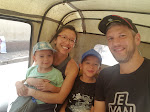 |
| Our first ever date - the Mayan ruins in Copan Ruinas |
This coming July will be the 10-year
anniversary of UrbanPromise Honduras (UPH). For those of you who do not know, UPH is a non-profit organization that works
with kids and youth in Copan Ruinas, Honduras. Ten years ago, I (Matt) helped found the organization with my two friends Blair
and Rachel. Blair continues to work with UPH from the USA and Rachel still lives in
Copan Ruinas. We spent several years living in Honduras, developing the
organization and running programs. Starting and working with UPH was an important part of my life, and the organization still remains close to my heart. During that
time I learnt a lot about living cross-culturally, working as part of a team, and living by faith. I fell in love with the Honduran people and the community
in Copan Ruinas, and I made many great memories from our time living there.
 |
| (left) White water rafting trip with the UPH youth. (right) Kids from Camp Hope, our first after school program. |
UPH started as a vision of our good friend
Blair while he was teaching at a bilingual school in Copan Ruinas in 2007. I remember him sharing his vision with me in
typical Blair fashion, seemingly out of nowhere, full of passion and with an
invitation to join him in the work. I knew right away that it would be an adventure like no
other, and it didn’t take me long to get excited about the idea as well.
 |
| (left) The three founders with UrbanPromise President, Bruce Main. (right) Duct-tape Man fighting some evil villain. |
After I agreed to join, we moved to the headquarters of UrbanPromise USA in Camden, NJ. We were there to learn about starting an
organization and to start laying the foundations of what would later become
UPH’s mission, vision, structure, and programs. It was an exciting time, but
also a challenging and stretching one in many different ways. We spent many days dreaming of our future programs in
coffee shops, arguing over the wording of our mission statement around boardroom tables, and making awkward fundraising pitches to potential donors. It was also during this time when Rachel, the third member
of the initial UPH team, joined the organization.
 |
| (left) A regular day at the first UPH office;. (right) Rachel teaching at our second ever summer camp. |
Eventually, we raised enough money to
survive for a few months and we moved down to Copan Ruinas to start programs.
We started with an English summer camp for students of a bilingual school. There
were many speed bumps and mistakes made, but we had a pretty decent turn out and
lots of fun. After that summer, I continued as Program Director for our first after-school program, which I named Camp Hope. We ran it in the community of
Nueva Esperanza, which means “New Hope“ in Spanish. I wanted the camp
to be a place of hope for the kids, a place where they could feel the hope for
deeper friendships, for a better future, and for experiencing the love of God. These same hopes kept me going during
tough times in Honduras, and they continue to motivate me in cross-cultural ministry today.
 |
| (left) Francisco and Nicole washing paint brushes. (right) Some boys from Camp Hope with some bald guy. |
After almost two years in Honduras, we decided it was time to return to Canada. However, UPH is still running programs and doing great
work. They have been steadily and faithfully growing ever since, touching the
lives of hundreds of people in Copan Ruinas throughout the years. I feel very
proud and lucky to have been a part of UPH’s beginnings. Not many people have the
opportunity to live in another country, start something that makes a difference
in people’s lives, or be able to work with their best friends. UPH allowed me to
do all of these things, for which I am forever grateful to God, the UPH
team, the people of Copan Ruinas and to all the friends and
family that helped support the team and I. Many of you who
are reading this are the same people who prayed for us faithfully and supported us
financially. To all of you who did so, I am incredibly thankful. I hope you will join in the celebration, from wherever you are in the world.
 |
| (left) Kristin and I with the family I lived with for eight months in Honduras. (right) Mayan ruins field trip with camp kids. |
In July, we are planning to attend the
10-year anniversary celebrations in Honduras. It has been a number of years
since we have been able to visit Copan Ruinas, and never as a family. We are excited to show our kids this part of our history.
If you would like to be a part of helping us get to Honduras by financially contributing to the cost of our trip, you could make a donation to our MCC Personal Drawing Account. Choose the "in memory, in honor, or in support of someone" section and write in the comments box "Matthew Wall and Kristin Cato PDA". We are trying to raise $2500 for the trip. See our Support Us page for more donation details.
And if you want to know more about UrbanPromise Honduras or support their work, go to www.urbanpromisehonduras.org.
Thank you all for being a part of our journey, in the past and the present.
Blessings,
Matt
 |
| My last day as Program Director at Camp Hope. |














